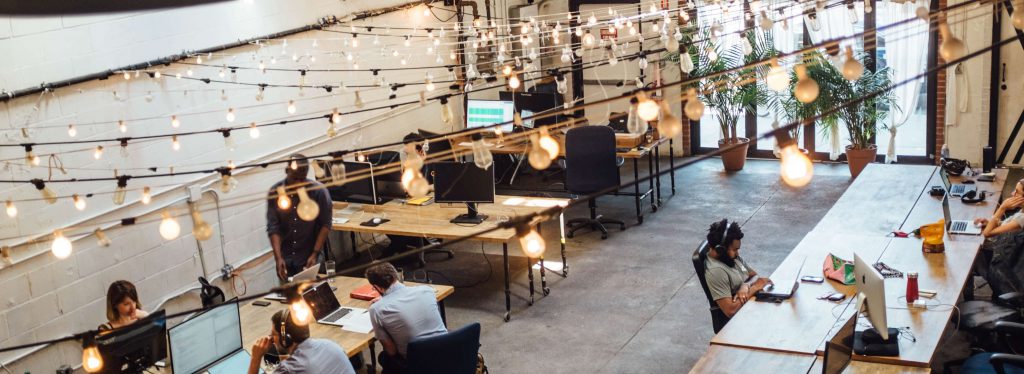COVID-19 and now? How to organize your employees’ return to the office
The year 2020 has put the working world and the way work is organized to the test. Surprised by the forced home office, companies had to adapt in a hurry and appropriately equip themselves to maintain their activities despite the restrictions they experienced.
With things getting started again and as employees gradually prepare to return to the office, the question arises as to the usefulness of the physical office and its future. A closer look at the question reveals that in the collective consciousness, whether among employers or employees, the physical office is still very much present. It is simply reinventing itself to best meet everyone’s new needs.
So it is not a matter of doing away with the office, but reorganizing it to successfully create a “bridge” between the home office and working in the office – and all this in what remains a very tense health environment.
If we look at the growth of working from home in 2020, there is naturally a clear increase. However, one cannot really speak of a “revolution” in the world of work, since this type of collaboration was already commonly used and demanded by employees before the health crisis.
87% of employees in September 2020 already preferred at least one home office day per week.1
What has changed, however, is the number of home office days required, which has increased from one to two days on average.

Does the general spread of home offices mean the end of the traditional offices?
Another question that can legitimately be asked is: Will employees who have now tasted the “joys of the home office” ever want to return to the office?
Here too, the answer does not indicate a revolution, but rather a rebalancing our various workplaces.
Indeed, it is clear that humans remain social beings requiring at least some interaction with others. Video conferencing tools, while very useful, have their limitations and cannot replace the pleasure of meeting. For example, 34% of employees at a company who work 100% from home say what they miss the most is not being able to see their colleagues face-to-face, while only 16% would like to continue working only from home.2 On the company side, it has also been proven that employees who were used to collaborating in the same physical space built closer relationships and were on average more productive and satisfied with their working conditions.
No, the office is not dead and we will continue to work there, but when we go to our workplace, we will go there seeking teamwork rather than individual work.
Back in the office: How does one organize oneself as a manager?
As we understand it, the challenge of the next few months will be to organise the return of employees to the office calmly and under good hygienic conditions. Social distancing, wearing a mask, hygiene measures… are terms that have become an integral part of our everyday lives and which companies must also adopt in their organization and in the general conditions for their employees.
At ROOMZ, this problem arose quickly after the first containment last March. Our client Lonza, the world’s largest contract manufacturer in the pharmaceutical and biotech industries, which already uses ROOMZ screens to manage its meeting rooms, turned to us for an effective solution to integrate the Flex Office concept into its work organization. In response to this request, we developed myROOMZ, an intuitive Web application that enables employees to find and book an available office for the coming days from home, while complying with the prescribed hygiene measures. Lonza quickly integrated myROOMZ into its work organization. The solution has made it significantly easier to organize staff turnover after the lockdown.
Learn more about Lonza’s success story here.

Those in charge of coworking spaces face new challenges when it comes to ensuring a safe return to the office. For most, these are new issues for which they are not prepared and for which they have not been trained. We summarize the problem below in three essential steps:
1. Rethinking Workspace Design
Redesigning coworking spaces primarily involves a phase of reflection, trying to answer the question of benefits. Why do employees come to the office? To work together? To discuss with their colleagues? To hold meetings? Several answers to this can be found through analysis of behavioral data. It is therefore important to distinguish between two types of data that need to be taken into account:
- Reservation data to answer the question: “Which space is used or not used in my company?”
- Usage data, such as that which is obtainable from sensors, can provide information about which spaces are most used in an organization and how they are used.
All this information makes it possible to make the right decisions and draw the contours of the office of tomorrow by defining the strategic areas to be developed in its structure.
2. Adapting Work Methods
A second step is to adapt the organization to the new applicable standards, such as: respecting social distances between offices/employees in accordance with legal requirements, introducing a maximum occupancy rate per floor, implementing an efficient cleaning service that makes it possible to provide disinfected rooms after each use… For this step, you need to be equipped with powerful software that accompanies you throughout the transition process and which especially can be adapted to the development of the situation. Features such as the ability to reserve one of two offices, the digitization of building plans or a real-time view of the situation are tools that enable you to create a safe working environment.
3. Raising Employee Awareness
A recent survey shows that 49% of employees fear catching the virus in the office.3 To avoid encouraging fear, it is therefore crucial to integrate employees as much as possible in the transition process to gain their trust. Changes must be made transparently to be accepted by staff. Do not hesitate to inform staff about the tools you intend to introduce, share current data with the various employees (e.g. average occupancy rate per floor) and show that you are taking the necessary measures so that employees need not worry about their safety at work.
The year 2021 will be marked by a continuation of the digital transformation in companies in order to coordinate our different workplaces. The focus is on adapting the use of coworking spaces while ensuring a safe environment for all. If you would like us to support you during this transition period and deploy a complete solution in your company, please do not hesitate to contact us so that we can discuss your issues with you.